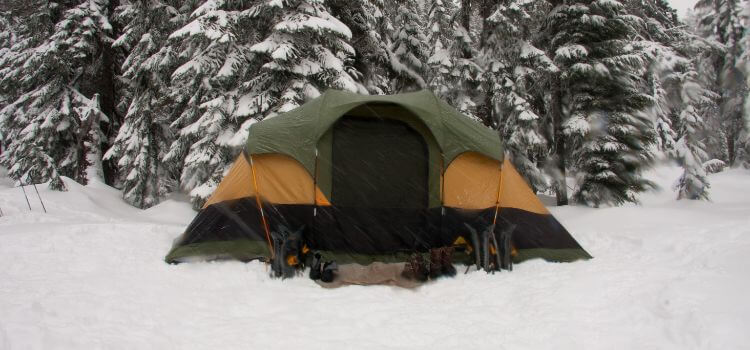As an Amazon Associate, I earn from qualifying purchases
As the crisp air of winter settles in, many outdoor enthusiasts eagerly anticipate the unique experiences that winter camping brings. However, venturing into the cold requires careful preparation, especially when it comes to insulating your tent for warmth. Knowing how to insulate a tent for winter camping is key to ensuring a comfortable and enjoyable outdoor adventure.
From preventing drafts to retaining heat, proper insulation can make all the difference in your camping experience. So, let’s delve into some effective strategies for keeping your tent cozy in even the coldest conditions, allowing you to fully embrace the beauty of winter while staying warm and snug.
To insulate a tent for winter camping, use foam padding or other flexible insulation materials between the layers. Additionally, you can add a foil thermal blanket on top of the tent to reflect your body heat back inside.
Methods for Insulating a Tent for Winter Camping

Insulating a tent is crucial for winter camping to trap heat and keep you warm throughout the night. There are several effective methods for insulating a tent:
1. Using Foam Padding
One of the simplest and most effective methods to insulate your tent is by using foam padding. You can place foam pads on the floor of your tent to create a barrier between you and the cold ground. These pads not only provide insulation but also offer extra comfort while sleeping. Make sure to choose high-density foam pads for better insulation.
2. Adding An Extra Rainfly Or Tarp
Adding an extra rainfly or tarp over your tent can provide additional insulation. This extra layer will help to keep the heat inside and prevent cold air from seeping through the tent’s fabric. Ensure that the rainfly or tarp is properly secured to avoid any water leakage. This method is particularly useful in areas with heavy wind or snow.
3. Using Flexible Insulation Materials
Flexible insulation materials such as foil, fiberglass, vinyl, or bubble wrap can be used to insulate the interior of the tent. These materials can be easily attached to the tent walls and ceiling using clips or adhesive tapes. They help to reflect body heat back into the tent, creating a warmer environment. Ensure that the insulation materials are dry to maintain their effectiveness.
4. Placing A Thermal Blanket On Top Of The Tent
Another effective method is to place a thermal blanket on top of the tent. This will create an additional layer of insulation and prevent heat loss through the tent’s roof. Make sure to secure the thermal blanket tightly to the tent to prevent it from slipping off or getting damaged by wind or snow. The thermal blanket should cover the entire tent, including the rainfly.
Choose the method that best suits your needs and camping conditions. Combining multiple methods can provide even better insulation for extreme cold weather camping. Stay warm and cozy during your winter camping adventures!
Tips For Staying Warm In An Insulated Tent

Keep warm during winter camping by insulating your tent. Use flexible materials like foil, fiberglass, vinyl, or bubble wrap for internal insulation. Add additional insulation between layers using foam pads, newspapers, or emergency blankets to trap heat and stay cozy.
Choosing A Warm Sleeping Bag
One of the most important factors in staying warm during winter camping is choosing the right sleeping bag. Look for a sleeping bag with a temperature rating suitable for the coldest temperatures you expect to encounter. Opt for sleeping bags with synthetic insulation or down fill, as these materials provide excellent insulation. It’s also important to consider the shape of the sleeping bag. Mummy-shaped sleeping bags are more efficient at trapping body heat than rectangular ones. Additionally, make sure the sleeping bag fits snugly around your body to minimize heat loss.”
Using Body Heat To Stay Warm
Your own body heat can be a valuable source of warmth when camping in cold weather. There are several ways you can utilize body heat to stay warm inside your insulated tent. First, make sure to dress in layers, as this helps trap body heat and provides better insulation. You can also use hot water bottles or heat packs to warm up your sleeping bag before getting in. Another effective method is sleeping in a sleeping bag liner made of a heat-reflective material, such as a thermal liner or an emergency blanket. These liners help retain and reflect body heat, keeping you warm throughout the night.”
Using Tent Heaters
In extreme cold conditions, using a tent heater can provide an extra boost of warmth inside your insulated tent. There are different types of tent heaters available, including propane heaters, electric heaters, and catalytic heaters. When using a tent heater, it’s essential to follow manufacturer instructions carefully and ensure proper ventilation to prevent carbon monoxide poisoning. Place the heater in a safe location away from flammable materials and use a carbon monoxide detector inside the tent for added safety. Always monitor the temperature inside the tent and adjust the heater accordingly to maintain a comfortable and safe level of warmth.”
Preventing Moisture And Drafts
Moisture and drafts can wreak havoc on your comfort and warmth inside an insulated tent. To prevent moisture buildup, make sure your tent is properly ventilated. Keep the tent’s vents open during the day and crack them open slightly at night to allow for airflow without letting in too much cold air. Additionally, use a groundsheet or tarp underneath your tent to create an extra barrier against moisture seeping through the floor. To block drafts, seal any gaps or cracks in your tent using seam sealer or duct tape. You can also utilize draft stoppers or blankets to cover any openings or vents. By preventing moisture and drafts, you’ll maintain a dry and cozy environment inside your insulated tent.”
Frequently Asked Questions On How To Insulate A Tent For Winter Camping
How Do You Winterize A Camping Tent?
To winterize your camping tent, follow these steps: Clear the ground and pitch your tent on a flat spot protected from wind. Build a windbreak. Winterize your tent by adding insulation between layers, using foam pads or other dry materials.
Consider using a tent heater for extra warmth. Lastly, choose a warm sleeping bag.
What Is The Best Material To Insulate A Tent?
For the best material to insulate a tent, you can use flexible materials like foil, fiberglass, vinyl, or bubble wrap. These materials can provide effective insulation for your tent. Additionally, you can also add insulation between the layers of your tent using foam pads, newspaper, or emergency blankets to trap heat and keep the interior warmer.
How Can I Make My Winter Tent Warmer?
To make your winter tent warmer, add insulation between the layers using foam pads or other dry materials. You can also use an emergency blanket or foil thermal blanket on top of the tent to reflect body heat. Additionally, choose a warm sleeping bag and camp in a flat, wind-free area.
Can You Insulate A Tent With Blankets?
Yes, you can insulate a tent with blankets. Simply place a foil thermal blanket on top of the tent, between the insect mesh and rainfly. The blanket will reflect your body heat back into the tent, helping to retain warmth.
Conclusion
Cold ground. This will help prevent heat loss and keep you warmer throughout the night. Additionally, using materials like foil fiberglass, vinyl, or bubble wrap can provide internal insulation to further retain heat. Don’t forget to build a wind break and winter-proof your tent to keep out the cold air.
With these tips on how to insulate a tent for winter camping, you can ensure a cozy and comfortable winter camping experience. Stay warm and enjoy the beauty of the winter outdoors!
As an Amazon Associate, I earn from qualifying purchases

